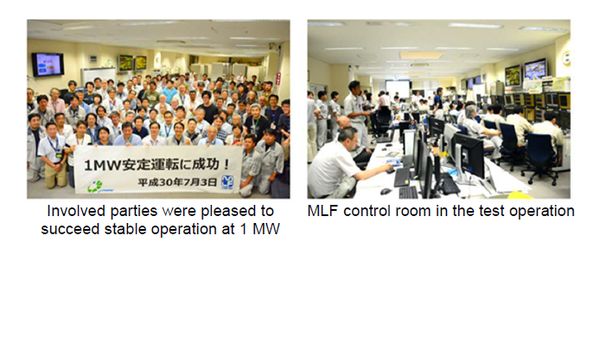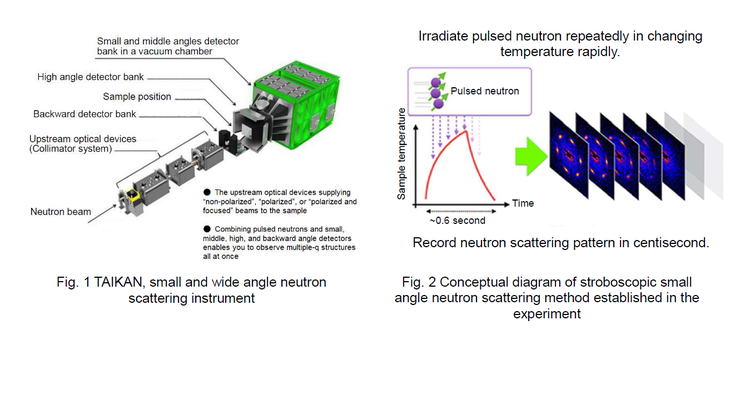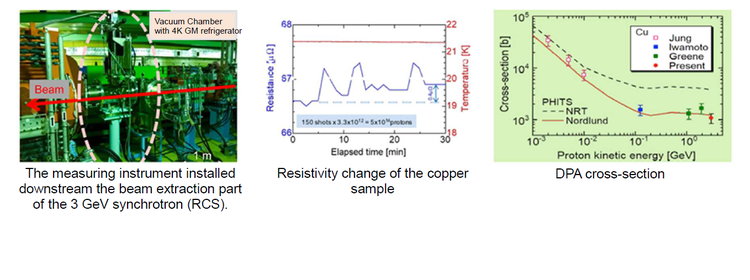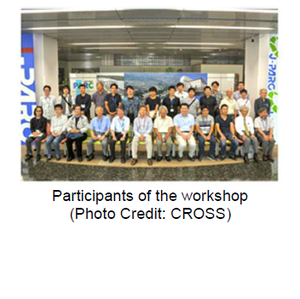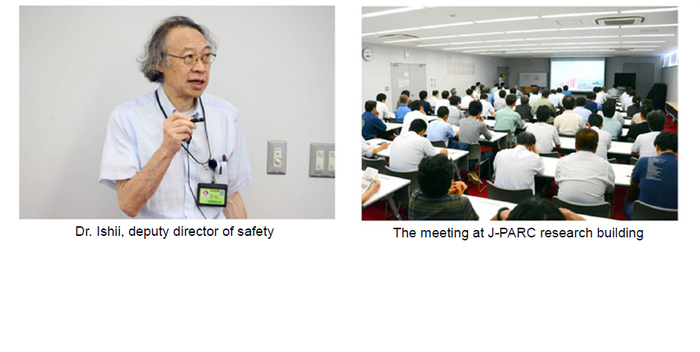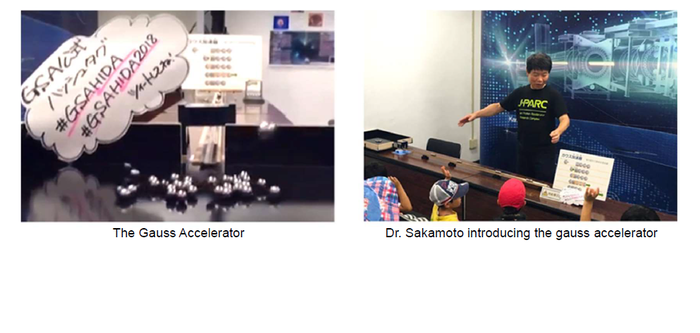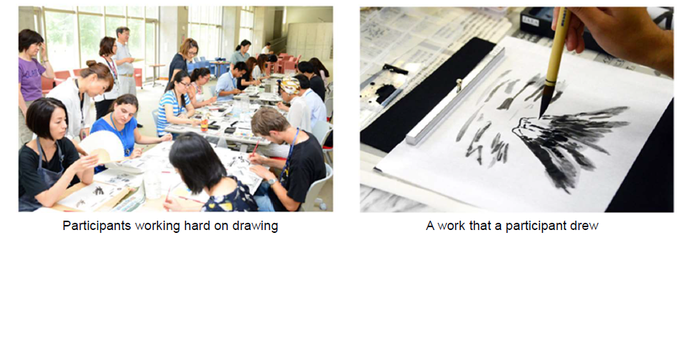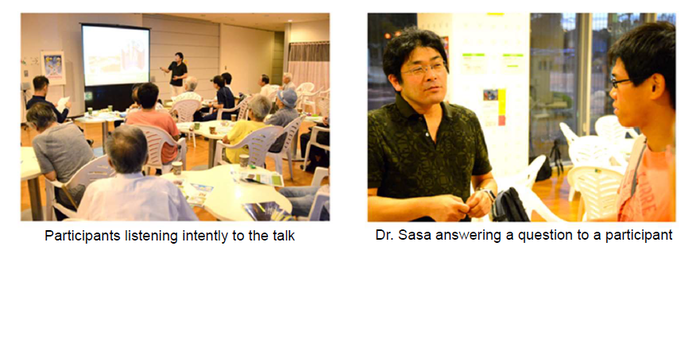J-PARC NEWS July 2018 (Issue #159)
■Succeeded in Stable Operation at 1 MW in the MLF! (July 3)
At the J-PARC Center, we succeeded in continuous operation with a beam power equivalent to 1 MW at the MLF on July 3. In the MLF, we were in operation with a beam power increased to 500 kW from April 19, and we were able to continue operation with an extremely stable operation rate of 93% until the early morning of June 30. We implemented a test operation to increase operation output before the summer maintenance period and succeeded in continuous operation with a beam exceeding about 935 kW in time average. This corresponds to a pulse beam output of 1 MW, which is the designed value, converted to the beam output received by the mercury target for generating neutrons and the rotating target for generating muons. As for the mercury target, we will evaluate the influence exerted on a target container by the previous beam during the summer maintenance period and plan to improve the target container based on the result. After that, we will further aim for use operation at 1 MW in the MLF while accumulating operational experience.
■Measured magnetic vortex generation/annihilation process in hundredths of a second -Succeeded in stroboscopic photography with pulse neutrons at J-PARC - (Press Release on July 19)
A collaborative research group, which consisted of Taro Nakajima, researcher at RIKEN and Yasuhiro Inamura, vice-chief researcher at the Neutron Utilization Section and other members, successfully observed a "stroboscopic photograph" with a high temporal resolution in hundredths of a second, using pulse neutron beams* of the MLF, a changing process due to rapid temperature rise/fall, with respect to a minute magnetic vortex (magnetic skymion) that appears in the compound MnSi containing manganese and silicon. They succeeded for the first time in observations such as the state of magnetic skymion annihilating due to temperature rise and the state of the magnetic skymion generated in the rapid cooling process remaining in a "supercooled" condition at a low temperature where it cannot naturally exist. This research was posted in the online version (as of July 23, July 24 - Japan time), prior to being posted in the "Physical Review B" which is an international scientific journal.
*BL15 Neutron small and wide-angle scattering instrument "TAIKAN"
■Succeeded in the measurement of DPA cross-section of copper for 3 GeV proton (J-PARC, Nuclear Transmutation Division)
In order to improve the accuracy of the radiation damage estimation of beam window materials used for the Accelerator Driven nuclear transmutation System (ADS), we succeeded in measuring the DPA* cross-section of copper with respect to 3 GeV proton incidence. The displacement cross-section can be derived from resistivity change of the irradiated sample material in the cryogenic temperature. We installed a measuring instrument using a refrigerator just downstream the beam extraction part of the 3 GeV synchrotron (RCS) and conducted an experiment. The measured value is one third smaller than the value with the Norgertt-Robinson-Torrens (NRT) model which has been used as the standard so far, and it has been revealed that the latest calculation model (Nordlund model) shows good agreement with the measured value.
* Although displacement per atom (DPA) is widely used as an indicator to define the radiation damage of beam window and target materials at the accelerator facilities, there is few measurement data on the DPA cross-section.
■J-PARC Neutrino beamline upgrade Technical Advisory Meeting (June 21 - 22, J-PARC)
At the neutrino experimental facility, we are advancing a plan to increase the intensity of the proton beam from the accelerator (Main ring) to 1.3 MW. We held the Technical Advisory Meeting about the upgrade plan on June 21 and 22, chaired by Dr. Kazuhiro Tanaka of J-PARC, inviting Dr. Marco Calviani from the CERN (European Organization for Nuclear Research), Dr. James Hylen from the Fermi National Accelerator Laboratory in the United States, Dr. Nobuhisa Fukunishi from the RIKEN, and several other experts from around the country. From the persons in charge of the neutrino section, concrete technical study situations about experiment facilities and the upgrade plan were reported, active question and answer sessions about the contents were performed, and meaningful comments on future responses were presented by the committee.

■J-PARC The 21st WS "Dynamics of Biomaterials and Hydration Water and Neutron Scattering" (July 2, IQBRC)
Neutron scattering provides important information on the dynamics (behavior) of biomaterials such as proteins in solution. This time, we held a workshop in cooperation with CROSS, by inviting Dr. Alexei Sokolov of Tennessee University in the U.S., the world's leading expert in the research in this field, and Dr. Fumio Hirata of TOYOTA RIKEN. Dr. Sokolov has been a driving force for many years of the research field on protein dynamics transition by neutron, and Dr. Hirata advocates a handling theory including hydration water in this field. At the WS, discussions were held on the theme of biomaterials and software matters and the cutting-edge of hydration water dynamics research, and measures to share information and develop new users were examined.
■Fiscal 2018 "Safety and Health Liaison Meeting with J-PARC Contractors, etc." (June 29, J-PARC)
Operation of J-PARC facilities and maintenance work of facilities and equipment are carried out by many contractors. The Safety and Health Liaison Meeting is held annually with the aim of sharing safety awareness among these subcontractors and our staff members and ensuring thorough safety assurance. This fiscal year, 70 persons from 68 companies and 15 persons related to J-PARC participated, and Dr. Tetsuro Ishii, J-PARC deputy director of safety introduced J-PARC's recent situations, good cases of safety measures, accidents at the Japan Atomic Nuclear Agency during the past year and their causes, etc. and tried to raise safety awareness of participants for the summer maintenance work to be started from July.
■J-PARC Exhibited at the GSA (GEO-SPACE ADVENTURE) 2018 (July 14 - 15, Kamioka-cho, Hida-city, Gifu-prefecture)
The GSA to be held in Kamioka-cho every summer is an underground exploration event which is performed using the actual tunnel of the Kamioka mine and the cutting-edge research facilities of Astrophysics such as Super Kamiokande (SK). We have cooperated as an exhibitor since last year in the same event operated by the "GSA Executive Committee", which is put on by Hida citizens and volunteer staff. On July 14 and 15 this year, at the Kamioka-cho Community Center, we performed briefings about the experiment of the Gauss accelerator which enables the nuclear fracturing reaction to be imaged by visual observation, the outline of J-PARC’s facilities by panel exhibit, and the experiments J-PARC are working on including the T2K experiment. During the period, many visitors seemed to be interested in these experiments.
■SUMI-E INK-PAINTING (July 20, Nuclear Science Research Institute)
As one of the various events we put on to deepen exchanges with overseas researchers and other visitors, in July we held the sumi-e ink-painting experience classroom. After listening to the explanation such as the basic brush usage of ink-painting from the staff, everyone in the overseas staff engaging in research at J-PARC and JAEA tried to draw a picture to his or her own liking while looking at the samples and enjoyed ink-painting that allowed him or her to feel Japanese culture.
■J-PARC Hello Science, Reducing Waste in Nuclear Power Generation in Hybrid Nuclear Reactor - Nuclear Reactor Driven by Accelerator "Accelerator-Driven System" - (June 29, Tokai Industry and Information Plaza "ivil")
In the Science Cafe in June, Dr. Toshinobu Sasa, the Leader of the Target Technology Development Section, Nuclear Transmutation Division gave a lecture on "nuclear transmutation technology" for reducing the harmfulness of waste in nuclear power generation using an accelerator. The nuclear transmutation technology aims to apply an idea of sorting garbage produced in everyday life and separately performing optimized disposal, to the nuclear power field to reduce the load of nuclear waste. He explained that J-PARC is researching a new nuclear reactor "Accelerator-Driven System" (ADS) that efficiently and safely transmutes nuclear waste by combining an accelerator and a nuclear reactor. Harmful substances are extracted from waste in nuclear power generation, and are converted into safe substances by ADS for making disposal of the waste easier.

